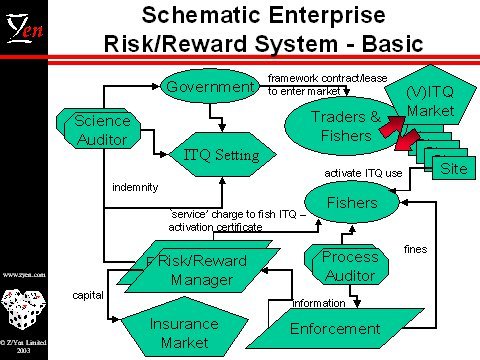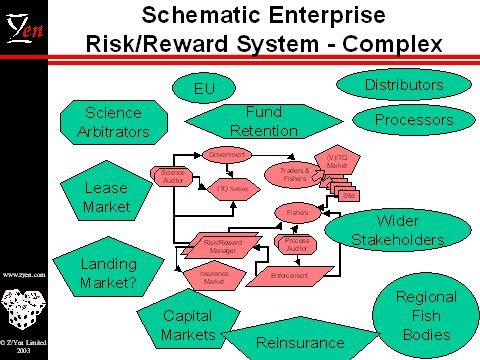Risk/Reward Management and Fisheries
Background to Fishery Resources and Risk
It has become clearer and clearer over time that fisheries policy problems are particularly exacerbated by two characteristics common to natural resource management:
- the degree of uncertainty: in fisheries uncertainty stems from a large number of unknown quantities, difficulties with measurement and poor tools for handling uncertainty, for instance which fish eat what when and where? what is the investment profile of a fisherman? can we estimate predicted environmental changes? how do we model decisions under uncertainty?
- the complexity and holistic nature of managing sustainable stocks: no part of the problem can be isolated and solved in isolation. Stocks affect economic returns affect investment affect politics affect communities affect compliance affect stocks, etc.
Risk/reward management is an increasingly common, albeit still emergent, approach to managing systems which have large degrees of uncertainty and complex underlying systems. Risk/reward approaches are in use in industries ranging from shipping through to health, from aerospace to brownfield land in both the public and private sectors. Risk/reward approaches involve a variety of mechanisms which would be new to UK fisheries, e.g. tradable markets, option pricing, insurance mechanisms, risk managers and long-term asset indemnification.
The Prime Minister’s Strategy Unit (PMSU) held a half-day workshop on 11 September 2003 to explore “what would a properly risk/reward-managed fish industry look like?” The primary objective of the workshop was to explore the feasibility of applying risk/reward management to fisheries policy. The workshop tried to see what might be learned from risk management approaches as well as other regulatory approaches to natural resources and how these lessons might apply to UK fisheries strategy.
Thoughts on the Day
The attendees seemed broadly to agree with three assertions:
- risk analysis of fisheries will always be an incomplete task. There are too many variables and too many ways of structuring risk;
- fisheries are too complicated for deterministic modelling. The variables interact with each other in complicated, and unknown, ways;
- the initial conditions needed to begin any modelling could not be known with great accuracy or confidence.
In many ways, fisheries exhibit the characteristics associated with models that are used to illustrate Chaos Theory.
Risk/Reward Problems in Fisheries
The workshop agreed that there were a number of headline items indicating that the fundamental management of fisheries had a number of problems, so-called ‘sore thumbs’:
- antagonism between the owner of the assets (government) and the managers (fishers) with little trust either way;
- high cost of government management, 20% of the (legal) fishing industry or £8,000 per fisherman per annum;
- illegal landings approaching 50% of landed fish in some cases;
- uncertainty over quota ownership leading to complications in management and finance;
- perceived high volatility of stocks and returns between species, regions and over time leading to questions of the limits of scientific management;
- fear of collapse;
- decommissioning itself encouraging excess capacity in cases, as opposed to reducing capacity.
Risk mis-allocation lies near the core of many problems as evidenced by, among other things:
- the disconnection among stocks/science management & politics & economics
- unclear ownership of assets (e.g. quotas), risks and rewards;
- fundamental risk timing differences:
- government versus fishers: government is thinking about the longer-term stocks but handing out annual quotas;
- smoothing/pricing over cycles: there are large incentives to take fish while the fishermen can as opposed to thinking about the longer term economic management of the fisheries;
- government development and enforcement of input controls (mesh size, days at sea, etc.) leading to the government, rather than fishers, having responsibility for effectiveness of stock protection mechanisms;
- lack of collective responsibility & sanctions for fishermen who do not comply with regulations.
Risk/Reward Management and Fisheries
A basic start to risk/reward management is that risks must be priced and rewards given for proper management of a resource. By way of comparison with a property leasehold model where lease ≈ quota and freeholder ≈ government, is that the leaseholder has to return the property to the freeholder in its original condition. Despite the long timescales, there are a number of ways in which the risk of poor management is priced into the leaseholders actions. A freeholder can appoint a property manager who levies service charges based on their assessment of the need for common works and maintenance. Leaseholder behaviour is modified through costs, for instance, if the leaseholder fails to maintain the property, service charges rise and the value of selling the lease consequently decreases.
A basic risk/reward model for fisheries (see diagram “Schematic Enterprise Risk/Reward System – Basic” below) would involve individually tradable quotas (ITQs). ITQs might be traded by anyone prepared to sign a framework contract to enter the quota market, perhaps paying an entry fee, e.g. “buying a seat on the quota exchange”. However, while ITQs could be owned, in order to “fish” them, an activation certificate would need to be purchased from some government approved entities. Such a model would introduce a new agent, the so-called “Risk/Reward Manager”. The Risk/Reward Manager can sell activation certificates to ITQ holders who wish to fish (fishermen as opposed to traders). However, the activation certificate would indemnify the government for stock and environmental damage by the fishermen. Basically, at the end of the ITQ life, the government would “audit” the state of the returned asset and, if it has deteriorated, demand compensation from the Risk/Reward Manager.

A Risk/Reward Manager might be an insurance company, an environmental organisation, risk managers for mutual insurers (an existing industry) or even a government agency. In fact, they ought to be competitive, ensuring fishermen that the pricing decisions for activation certificates are free from coercion. Current enforcement information (infractions and near infractions) ought to be made available to them to help in pricing decisions about individual fishermen. The nature of the activation certificate contract should be left to be determined as a negotiation between the Risk/Reward Manager and the fishermen. Some Risk/Reward Managers might price these certificates up front for a year, some may make them dependent month-to-month on good behaviour, some might apply deductibles, etc. However, the indemnification to the government for return of the asset should be standard, allowing for outside auditors, arbitration, etc. Risk/Reward Managers might select a number of strategies ranging from cheap activation on some stocks to purchasing ITQs in order to withdraw capacity on stocks they foresee causing them indemnification problems.
Despite the introduction of just one new type of player, the dynamics change materially.
However, (see diagram “Schematic Enterprise Risk/Reward System – Complex” below) as pointed out in the beginning of this note, no problem can be solved in isolation. A wider picture needs to take account of the EU, wider stakeholders, processors, distributors, how funds are distributed, the tradability of “seats on the exchange”, how fish are landed and sold, reinsurance markets, etc.

In other words, while a risk/reward approach may well be the answer, there are a large number of detailed questions that need answering or parameters that need to be set, for instance:
Next Steps
The attendees agreed that a risk/reward approach seemed well worth further exploration with a view to a trial on some UK fisheries management. Clearly, there are a number of things needed well before a trial could commence, such as refining the proposition, conducting some modelling of the new system with a Risk/Reward Manager, evaluating the suitability of trial fisheries, engaging with wider stakeholders, dry-running the system, etc.
Z/Yen would welcome further discussion with interested parties about how the research ideas in this document might be developed and funded.